
A Few Stielhandgranate Variations:
Mod.24 w/Frag Sleeve
Mod.39b Smoke
Mod.43 (Desert Tan Paint)
Mod.24 (Classic)
Mod.24 (Winter Paint)
 |
A Few Stielhandgranate Variations: Mod.24 w/Frag Sleeve Mod.39b Smoke Mod.43 (Desert Tan Paint) Mod.24 (Classic) Mod.24 (Winter Paint) |
|
|
|
| Short History Arguably the most recognized German infantry weapon of the 20th Century. The German stick grenade design began in 1915, improving on the Pétards Raquettes concept which was a rudimentary early war improvised stick grenade. The basic design consisted of a heavy sheet metal can, filled with explosive, screwed to a wood handle. About 10 different variations were developed during WWI, each exploring different fuze mechanisms, explosive fillers and fabrication techniques. Fuzes were first friction delay, then impact, returning again to friction delay. Designs evolved, becoming lighter and simpler to manufacture. The stick grenade is easily held and thrown. It's shape also prevents rolling on the ground, a distinct advantage on sloped terrain. It also can be easily bundled together with other stick grenades making a larger weapon. On the negative side, it is bulky and cannot be thrown as far as an "egg" shaped hand grenade. By 1917 the final form was established, consisting of a large sheet metal warhead with a belt hook, screwed to a hollow wood handle containing a friction fuze with a pull lanyard. The detonator was inserted in the field. Instructions were printed on the grenade reminding the user to do so: Vor Gebrauch Sprengkapsel Einsetzen "BEFORE USING, INSERT A DETONATOR" After the war the design was slightly modified, utilizing a smaller head and the belt clip was removed, since it was just as easy to tuck the handle under a belt or pack webbing. The classic WWII "Potato Masher" was born. |
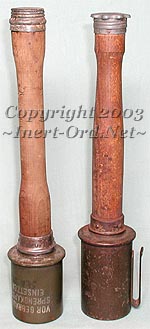 WWII - WWI Mod.24 - Mod.1917 |
|
|
|
| Basic Function Grenades were transported in metal suitcase style cases, stored in two rows, held in place by spring clips. The explosive is contained in a factory sealed warhead made of light sheet steel. A delay fuze is installed in the hollow handle attached to a lanyard. The lanyard reaches to the bottom of the handle with a heavy porcelain ball attached, so that when the end cap is unscrewed the ball drops out. The end cap has a spring-loaded cardboard disk that acts as an anti-rattle feature, pressing the ball into a recess in the end of the handle. To use, a detonator is attached to the fuze and the handle is screwed into the base of the head. There is a fuze-well in the head to accommodate the protruding detonator. The end cap is unscrewed and the ball drops out. The lanyard is pulled with the left hand as the right swings back to throw. |
|
 The fuze is made up of a delay element in a metal tube. A wire with an abrasive surface is set in a friction sensitive ignition compound and enclosed in the bottom end. Yank the wire out, via a lanyard, and it ignites the compound starting the 5-second delay. It works basically like a "strike anywhere" match, inside-out. |

|
|
|
|
| Manufacturing Changes As WWII progressed, features of the Model 24 were simplified to reduce assembly time and cost. There were three distinct mechanical variations having to do with the head attachment mechanics. I'm not aware of any formal Model number changes. (?) A. Machined Threads. Screw Pin Attachment B. Machined Threads. Pierced Tab Attachment. C. Formed Threads. Pierced Tab Attachment. This last variation also utilized a modified head to match the threads. 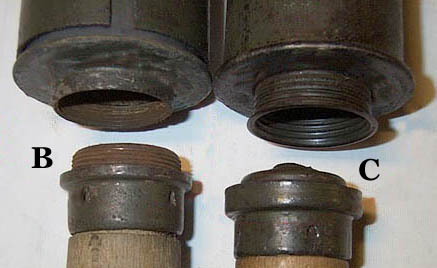 |
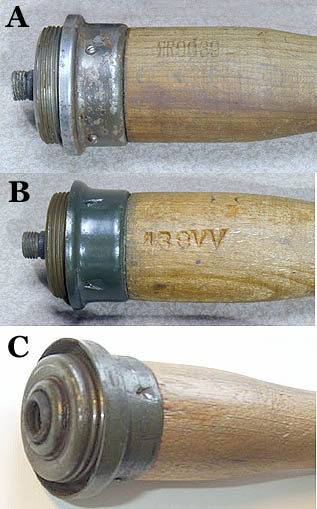
|
|
|
|
Fragmentation Sleeves For use in a defensive role, there are two types of attachable fragmentation sleeves. There is a grooved slip-over type with a retaining ring. The sleeve is pushed on from the top and three clips snap over the flange at the base of the grenade head. A locking ring is push down over those clips locking them in place. As with other weapons the SS subcontracted their own version, which was a simple press on smooth type. (Shown at top right.) Certainly must have been easier to produce. Both types were used throughout the war. |
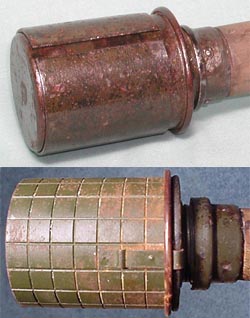 |
|
Nb. 39 Nebelhandgranate In 1939 the Stielhandgranate design was modified to create the Nebelhandgranate ("smoke hand grenade"). Smoke was used for masking protection from enemy fire and signaling. There are two variants, the Nb.Hgr.39 and the Nb.Hgr.39b The "b" version differs in the handle, having raised ridges and an additional white band to aid in identification at night. The Nb.39 “pot”contained a mixture of zinc powder and hexachlorethane which produced a smoke cloud upon ignition. Holes in the bottom provided an escape path for the smoke as it burned. |
|
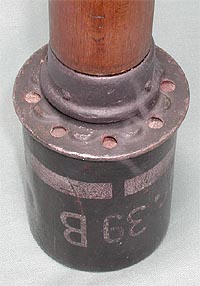 |
 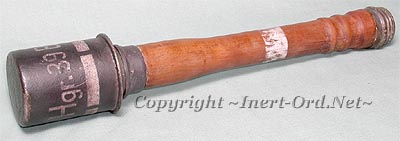 |
|
|
|
 Model 43 Stielhandgranate The last version of the "Potato Masher". |
|
|
This was a significant departure from the previous design and was clearly aimed at making grenade production
as simple as possible. The pull fuze and hollow handle were eliminated in favor of a solid handle with a simple formed
threaded end to screw into the head. The warhead was modified to use the Bz39, (Brennzünder 39) "Ignition Fuze 39",
which was the standard fuze in use for the Eihandgranate 39 "Egg Hand Grenade". One advantage of this configuration is the handle was not required for the grenade to function, since the head was now self-contained. An interesting feature of the Mod.43 in the photo is the rust outline of a smooth fragmentation sleeve which once was mounted. |